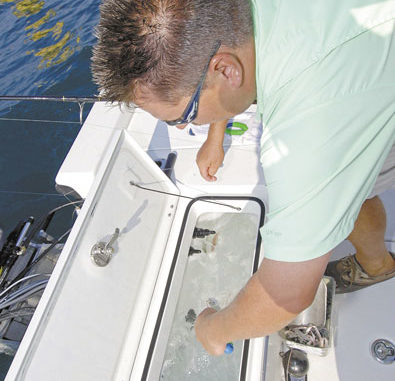
Artificial reefs are king mackerel magnets for fishermen off Wrightsville Beach.
August is hot enough to encourage second thoughts for any angler heading for the ocean on a calm day, so beginning a trip before sunrise is a great idea when the target is a big king mackerel.
Capt. Lee Parsons is a guide out of Wrightsville Beach, where the slow-trolling method of using live baits to catch king mackerel originated, begins searching for menhaden in the pre-dawn haze, with a double handful of cast net and a loop of net across one shoulder.
Once his livewell is full of menhaden, Parsons heads out through Masonboro Inlet to fish around one of several of the artificial reefs that are within easy reach of Parsons.
“I plan my trips to take me to several reefs in succession,” he said. “I start as far off as I want to fish during the day. I might hit the Schoolhouse, then the Dredge Wreck, then the 10-Mile Boxcars and lastly, the 5-Mile Boxcars. I usually don’t fish the Meares Harris (reef) this time of year because of the boat traffic.
“The water is hot everywhere, and you can catch kings in 84-degree water, but if you can find an area on the map that’s a little cooler, you should head for that spot first.”
Locating fish takes patience. Parsons said the hardest part of hot-weather fishing is deciding whether to wait out the fish or go on to the next spot.
“It’s all based on feeling,” he said. “If I feel like the fish are there, I might wait a long time. If not, I might wait only 30 minutes for a strike. If there’s a lot of boat traffic, I leave faster, because catching fish is less likely. If there’s a lot of boat traffic, I fish the farthest reefs first, then work my way back inshore. Sometimes, the bigger fish bite better closer to shore late in the afternoon, so it’s a good strategy.”
Parsons said that when he finds fish, multiple hookups are common. When he’s searching a reef, he slow-trolls with two flat lines and two long lines on each side, plus a downrigger line in the center of the spread. If the ocean is choppy, he adds an egg sinker or a rubber band with a bank sinker on his flat lines to take the baits below the waves.
He ties a 20-foot section of 40-pound fluorocarbon to his main line, then uses an Albright knot to tie a 14-inch length of No. 6 wire leader to the fluorocarbon. A No. 4 nose hook is tied directly to the wire leader, and a separate wire is used to tie on a No. 2 treble hook trailer. He leaves the trailing hook free-swinging, and if he is fishing a large bait, he ties on a second trailer.
“I fish the lines no more than 75 feet behind the boat,” he said. “You don’t want the fish to get much of a head start with all the structure on the artificial reefs and buoy cables to cut the line. If the fish are biting well, you can’t fish as many lines. I really like fishing when I can only get one or two lines in the water between king strikes.”
Parsons uses spinning rods with heavy tips. He said most anglers know how to use spinning rigs, while beginners have problems with revolving spool reels and lever drags. But a correctly sized spinning outfit will catch any king.
“I use Penn 550 Slammers with a bait-running feature, (which is) the key to using spinning reels,” he said. “When the fish runs with the bait, I flip it into gear to set the hook. I point the rod when setting the hook because it lightens the drag. After the fish is hooked, I raise the rod, which buries the hook even deeper. I use five to seven pounds of drag, unlike tournament anglers who use two or three pounds. I don’t want to land a skin-hooked fish, because it takes too much time and may still come off during the fight. I’m going for numbers of … fish, and I still catch plenty of fish topping 30 pounds. It only takes me five minutes to land a 30-pounder.”
A downrigger is an important piece of equipment for hot weather, which Parsons said will often drive king mackerel and baitfish schools deeper.
“At most artificial reefs, setting the downrigger line at 30 feet is deep enough. But if the baitfish are down 60 feet, I run the downrigger at 50 feet,” he said. “When I’m fishing the lower structure, I let the baitfish and height of the structure dictate where I’m going to run my downrigger baits. You need to keep your bait above the baitfish schools on your depthfinder so it looks hurt, confused and isolated, because it will get attacked more quickly.”
Parsons doesn’t use trolling skirts to dress up his live-bait rigs, believing that they interfere with the action of his baits and makes them swim unnaturally, but another Wrightsville Beach captain likes adding color to his live bait spread: Capt. Jot Owens, who also fishes the local wrecks and reefs for king mackerel. He usually heads to the 10- Mile Boxcars or Dredge Wreck Reef when he wants to catch kings.
“They are a little farther out, so the smaller boats don’t go to those reefs,” he said. “They are phenomenal places to fish. There are plenty of big kings out there, but when the weather is hot, you are also going to catch amberjacks, sharks and some big Spanish mackerel.”
Owens doesn’t waste fishing time filling his livewell with menhaden before slicing through Masonboro Inlet. Instead, he uses Sabiki rigs to jig up live baits.
“Sometimes you can see baitfish around the cable in the shadow of the buoy,” he said. “I just drop the rig down and jiggle it. The sardines or cigar minnows bite the feather jigs, and you haul them up quick, before a barracuda can eat them.”
Once he has enough, he rigs them on a live-bait rig consisting of four to five feet of No. 4 single-strand wire and a No. 2 Diichi Bleeding Bait hook. He rigs a No. 4x Strong Bleeding Bait treble hook five or six inches behind the single hook. The lead hook is imbedded in the menhaden’s nose, and the stinger hook dangles beside the menhaden. He uses trolling skirts of various colors ahead of the nose hooks and fishes some of baits “naked” at the same time.
“My rig is strong enough to land the biggest amberjack but subtle enough that it won’t scare off a king.” Owens said. “I fish a light drag, so that when a king mackerel strikes, he runs off as much line as he wants to take and it wears him down. But if you hook something stronger, like an amberjack, and he heads for the reef, you try to turn him away from the structure by tightening the drag.”
While he is catching bait, Owens watches the surface for baitfish schools and feeding predators. Once he has enough bait, he circles the area, watching his depthfinder.
“If the fish are on top, I just troll with a couple of flat lines,” he said. “But usually fish are down deep, too, so I set out a downrigger line at half the water depth. Even if I see fish deeper than that, I know I’m going to get too many trash fish if I set the downrigger any deeper.”
While Owens likes to catch any fish that bites, he said many anglers shy away from a reef if barracudas get too numerous.
“When it’s hot, the barracudas are going to be around,” he said. “If you see them swarming around the buoy or you start reeling in king mackerel heads with no bodies, you should try fishing farther from the structure. If the barracudas still eat your kings before you get them to the boat, it’s time to head for another artificial reef.
“The great thing about the Wrightsville Beach area is that you have your choice of artificial reefs, and any one of them can hold lots of kings. You just have to move from reef to reef until you find the right one.”

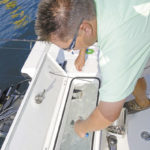
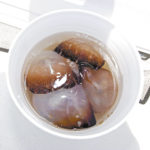
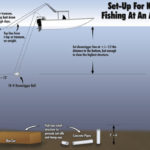
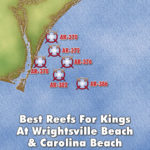




Be the first to comment